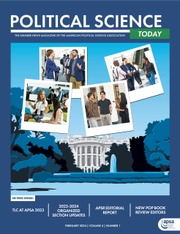Marginalized groups, including Indigenous populations, are often expected to “assimilate” by adopting the practices and norms of the dominant culture. Yet, many Indigenous groups prefer “accommodation” in the form of policies and legal measures that offer them recognition and allow them to preserve their linguistic and institutional heritage. In his recent APSR article (https://doi.org/10.1017/S0003055423000333), Carter studies Indigenous communities in Latin America and suggests that their historical experience with labor conscription can affect their likelihood of obtaining later accommodation from the state. He considers an episode of labor conscription in 1920s Peru; under President Augusto Leguía, a Road Conscription Law was adopted that required Indigenous men to provide unpaid labor to build the country’s first highway. The new highway’s construction followed the route of the earlier Inca Road that was built in the sixteenth century and had since fallen into disuse. The Road Conscription Law required Indigenous men to work on the section of the road falling within their own province, thus creating a set of eligible workers who resided in the provinces through which first the historical Inca Road, and later the new highway, was designed to pass. Comparing Indigenous communities in provinces hosting the highway to those residing in neighboring provinces, Carter finds that communities historically eligible for labor conscription have been more likely to successfully obtain accommodation from the state. They are more likely to have mobilized against the state at the time of conscription, and more likely to secure community registration and communal land titles in later periods. Carter’s work confirms findings from the broader literature on mobilization which indicates that a community’s ability to successfully rally the state is often grounded in the history of mobilization and exploitation.

Indigenous communities’ engagement with the nation state can lead to either assimilation or accommodation, yet little is understood about how these outcomes are achieved. Carter provides a succinct typology that situates assimilation and accommodation as a function of the degree of state control and support. While Indigenous communities seek high levels of state support and high levels of autonomy, resulting in accommodation, the state seeks to maximize its control by providing only moderate to low levels of support.
To obtain accommodation, Indigenous communities often mobilize and demand high state support along with policies that guarantee recognition and their ability to preserve their cultures. Carter argues that successful mobilization might be driven by historical legacies of resistance through changing power relations within the community, forming local Indigenous organizations, and solidifying collective memory. The historical labor conscription law described earlier allows Carter to compare two sets of Indigenous communities that are alike, except for the chance-determined eligibility to provide unpaid labor. The Peruvian highway proposed in the 1920s followed the route of the previous Inca Road built centuries earlier. This meant that whether an Indigenous community became eligible for the conscription program or not was up to historical chance, or as-if random. Carter uses this research design to compare accommodation across Indigenous communities located within the provinces where the road was built with communities in neighboring provinces where the road was not built.
The findings confirm that historical legacies of resistance matter for successful accommodation. Communities that had been historically conscripted to provide labor for road construction are more likely to secure communal land titles and are more likely to be registered with the state. He also finds support for the mechanisms: Indigenous communities eligible for labor conscription were more likely to mobilize against the state during the period of conscription, thereby signaling that they felt the restrictive law and redefined their power structures to resist it. Leaders of these communities were also more likely to join local Indigenous organizations. Finally, stories of conscription were passed down through songs, dance, and pilgrimages, thereby solidifying the collective memory of resistance.
These findings highlight that Indigenous communities are not passive recipients of state repression; instead, their resistance to exploitative laws such as labor conscription can enable them to become agents of change. While successfully resisting the state and obtaining accommodation does not do away with the costs of exploitative state policy that Indigenous communities have borne over generations, it shows the resilience of marginalized people and their ability to preserve and strengthen their longstanding cultural, political, and economic institutions. ■


